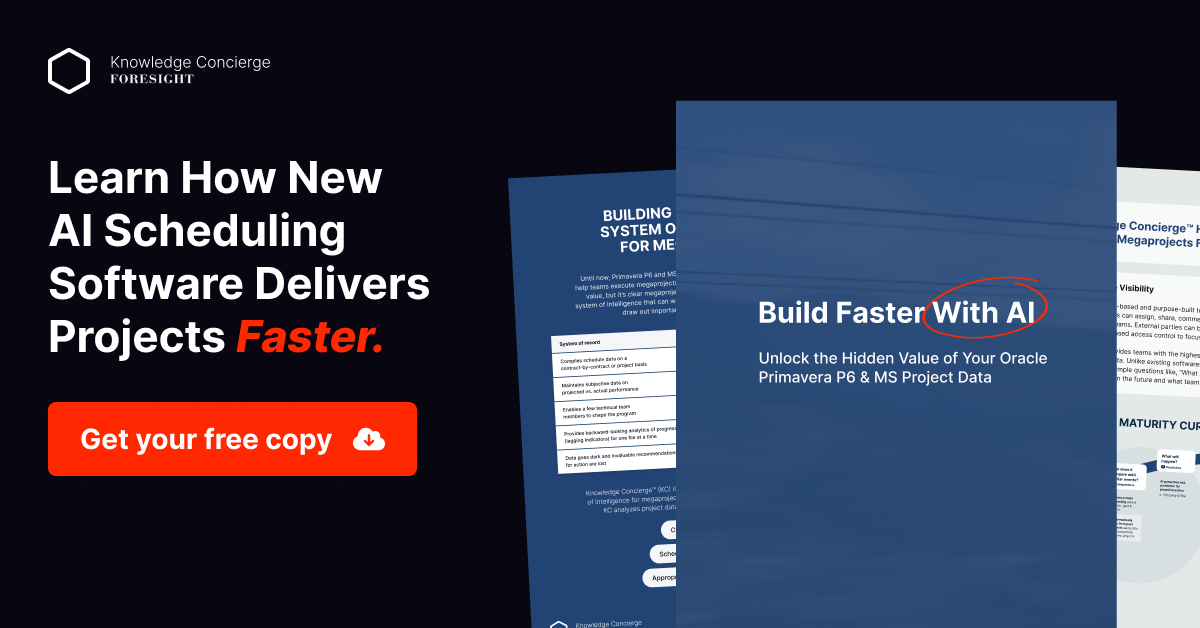3 Emerging Trends in Megaproject Planning
Megaproject planners and schedulers have had to be more adaptable than ever in the past few years. And as teams around the world face ongoing workforce shortages, economic uncertainty, and strained supply chains, it’s clear that the old way of doing things isn’t going to cut it anymore.
In this blog post, we will explore three emerging trends that are reshaping megaproject planning. From enhanced collaboration to the adoption of innovative tools, these trends are helping teams adapt — and succeed — in the new landscape of megaproject planning.
1. Cross-functional Collaboration
In the past, planning decisions mainly fell on project managers and schedulers. But recent challenges like supply chain delays and labor shortages have made planning a central function for the entire project team, including owners, designers, purchasers, human resources, and more.
By involving key stakeholders from various disciplines in the planning process, teams have been able to tackle the challenges of post-COVID construction more effectively. For instance, longer material lead times have become a significant concern, potentially causing delays and cost overruns. However, by engaging owners and designers early in the procurement process, contractors can ensure materials are ordered with ample time to avoid such disruptions. This collaborative approach improves efficiency and minimizes risks, ultimately leading to smoother project execution.
2. New Planning Methodologies
As cross-functional collaboration has increased, traditional planning methods like the critical path method (CPM) are being supplemented or replaced with more detailed and dynamic methodologies. Approaches such as Integrated Project Delivery (IPD), pull planning, and the Last PlannerⓇ System have gained popularity due to their emphasis on collaboration and short-term look-ahead windows.
The CPM often lacks the level of detail required to efficiently allocate resources, identify bottlenecks, or respond to changes in real time. In contrast, these new planning methodologies use a bottom-up approach to create a unified understanding of upcoming activities within shorter timeframes. By breaking down projects into smaller units, teams gain greater visibility into potential bottlenecks and dependencies, enabling proactive responses to risks or setbacks.
3. Data and Artificial Intelligence
In our opinion, data and artificial intelligence (AI) have transformed project planning more than anything else in recent years. More organizations are transitioning to cloud-based data infrastructures, which has enabled real-time communication and decision-making between on-the-ground personnel and project management professionals. Rather than waiting until status meetings to get updates and make revisions, teams can tackle blockers as soon as they arise.
With so much data available though, it’s impossible for project management professionals to analyze everything on their own. That’s where artificial intelligence comes in. With AI, project planners and schedulers can turn vast project data into useful insights in a variety of ways, including:
- Predictive analytics: With AI-powered predictive analytics, teams can forecast project outcomes to identify risks, bottlenecks, and opportunities for compression in the project schedule.
- Prioritization: AI can prioritize upcoming activities to help project teams save time and stay aligned on key objectives.
- Intelligent workflows: When action is needed, AI can suggest relevant workflows and next steps to achieve the desired outcome.
Foresight: Ready for the Future of Project Planning
Unlike other outdated scheduling platforms, Foresight combines industry-leading AI analytics with collaborative scheduling tools to help you gain control of your projects like never before.
Trained on data from more than 16,000 completed projects, Foresight’s proprietary AI engine uncovers hidden risks in your schedule using predictive analytics. Then, it empowers you to take action with the ability to assign, comment, tag, and share activities with other cross-functional users.
Foresight is methodology agnostic, so whether you’re team IPD or PRINCE2, you’ll always be able to plan your next steps with the click of a button.
Are you ready to see how Foresight can transform your project planning? Schedule a demo today to see how it works.




